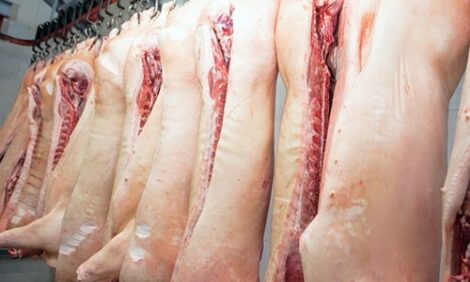



Bullet Proofing your Pig Business against a market you can't control
CANADA - Weaning 30.2 live pigs per sow per year is something that was unheard of only a few years ago, but today on one farm in Manitoba it is a reality.
Canada and the United States have 7.5 million sows on 40,000 plus farms. The latest annual PigCHAMP data indicates pigs weaned per female per year are 20.63. President and CEO Jim Long of Genesus Genetics says 30 pigs per year has been the dream of the industry for a generation.
Long said Woodland ships to market in 155 days, birth to market mortality is 11 per cent while receiving grade premiums at the very top of their packer’s grid. Woodland’s goal for 2007 is 32 pigs weaned per sow in the calendar year. The bar keeps rising.
In an interview during their celebration dinner in Portage la Prairie with the 60 customers that achieved over 25 pigs per year per sow in a calendar year, Long said their Genesus Genetics product is working very well in the market place.
“The first six months of this year, our sales are up 47 per cent, way beyond our expectations,” he said. “What it shows is confidence by our current and past customers and the ability of us to capture new customers.”
Getting more weanling per pig makes it a little easier to make money.
“I’ll say it this way. I haven’t ever heard of any one going over 25 pigs per sow per year not able to pay their bills,” said Long. “It is a way to position yourself and your business to be bullet proof to a market place we have no control over.”
As far as he knows, Genesus customer Woodland Colony is the first herd of in North America to achieve 30 pigs, weaned per sow in a calendar year.
“I think the reality is if anybody involved in the business 5 years ago, it was like a dream, like a fable, like the Promise Land,” he said. “You never even allowed yourself to think it was possible. It was an academic exercise.”
Six customers had over 29 pigs, which means other producers are knocking at that number of 30 pigs per sow. Long doesn’t know if they will achieve 30 because it is very difficult, everything has to go right.
“you have to be intense all the time in your production 365 days of the year. It is hard for people to do that,” he said. “We like to think our genetics are a significant portion of how they were able to do it. If you don’t have the pigs born, you can’t wean them, and that’s just the way it is.”
Woodland hog boss Jack Hofer says the achievement is a team effort, running a genetic line, with a huge genetic potential, and maximizing genetic potential with pro-per nutrition, feed and breeding management.
Raising the gilts to 220 days without boar exposure has also greatly benefited the colony’s pig production to achieve the 30.2 pigs per year.
Hofer says giving the gilts boar exposure when they are more mature bypassing the first estrus, and breeding them when they reach the second estrus after the second boar contact has the gilts producing huge litters.
“Once we wean them, we try to keep them alive,” he said.
Hofer’s team saw a decided difference moving from boar exposure at 180 days to 220 days, when they are more mature.
“You show the gilts boar exposure not because they are big, but when they are mature,” he said. “Instead of 180 days, we give them an extra 40 or 50 days more. Just because they are bigger, doesn’t mean they are mature.”
Woodland Colony built a barn for so many feeder pigs, but the more advanced in their weanling rates, the more often they kept running out of room. They went up to 940 sows, but dropped back down to 923 because of the extra pigs.
Costs went down big-time, and profits tripled by going the extra pigs per year.”
Dream has become a reality.
“We are proud to announce the first farm in North America to reach 30 pigs in a calendar year is a Genesus Genetics customer,” said Long. Woodland Colony of Manitoba reached 30.02, a farrow to finish operation. These results are a testament to the ability and professionalism of the Woodland staff; Manager Jack Hofer, Andy Gross, Breeding Manager, Mike Hofer, Farrowing Manager, Rick Hofer, Derrick Hofer, Irvin Gross and Dwayne Hofer.Long said Woodland ships to market in 155 days, birth to market mortality is 11 per cent while receiving grade premiums at the very top of their packer’s grid. Woodland’s goal for 2007 is 32 pigs weaned per sow in the calendar year. The bar keeps rising.
In an interview during their celebration dinner in Portage la Prairie with the 60 customers that achieved over 25 pigs per year per sow in a calendar year, Long said their Genesus Genetics product is working very well in the market place.
“The first six months of this year, our sales are up 47 per cent, way beyond our expectations,” he said. “What it shows is confidence by our current and past customers and the ability of us to capture new customers.”
Getting more weanling per pig makes it a little easier to make money.
“I’ll say it this way. I haven’t ever heard of any one going over 25 pigs per sow per year not able to pay their bills,” said Long. “It is a way to position yourself and your business to be bullet proof to a market place we have no control over.”
As far as he knows, Genesus customer Woodland Colony is the first herd of in North America to achieve 30 pigs, weaned per sow in a calendar year.
“I think the reality is if anybody involved in the business 5 years ago, it was like a dream, like a fable, like the Promise Land,” he said. “You never even allowed yourself to think it was possible. It was an academic exercise.”
Six customers had over 29 pigs, which means other producers are knocking at that number of 30 pigs per sow. Long doesn’t know if they will achieve 30 because it is very difficult, everything has to go right.
“you have to be intense all the time in your production 365 days of the year. It is hard for people to do that,” he said. “We like to think our genetics are a significant portion of how they were able to do it. If you don’t have the pigs born, you can’t wean them, and that’s just the way it is.”
Woodland hog boss Jack Hofer says the achievement is a team effort, running a genetic line, with a huge genetic potential, and maximizing genetic potential with pro-per nutrition, feed and breeding management.
Raising the gilts to 220 days without boar exposure has also greatly benefited the colony’s pig production to achieve the 30.2 pigs per year.
Hofer says giving the gilts boar exposure when they are more mature bypassing the first estrus, and breeding them when they reach the second estrus after the second boar contact has the gilts producing huge litters.
“Once we wean them, we try to keep them alive,” he said.
Hofer’s team saw a decided difference moving from boar exposure at 180 days to 220 days, when they are more mature.
“You show the gilts boar exposure not because they are big, but when they are mature,” he said. “Instead of 180 days, we give them an extra 40 or 50 days more. Just because they are bigger, doesn’t mean they are mature.”
Woodland Colony built a barn for so many feeder pigs, but the more advanced in their weanling rates, the more often they kept running out of room. They went up to 940 sows, but dropped back down to 923 because of the extra pigs.
Costs went down big-time, and profits tripled by going the extra pigs per year.”









